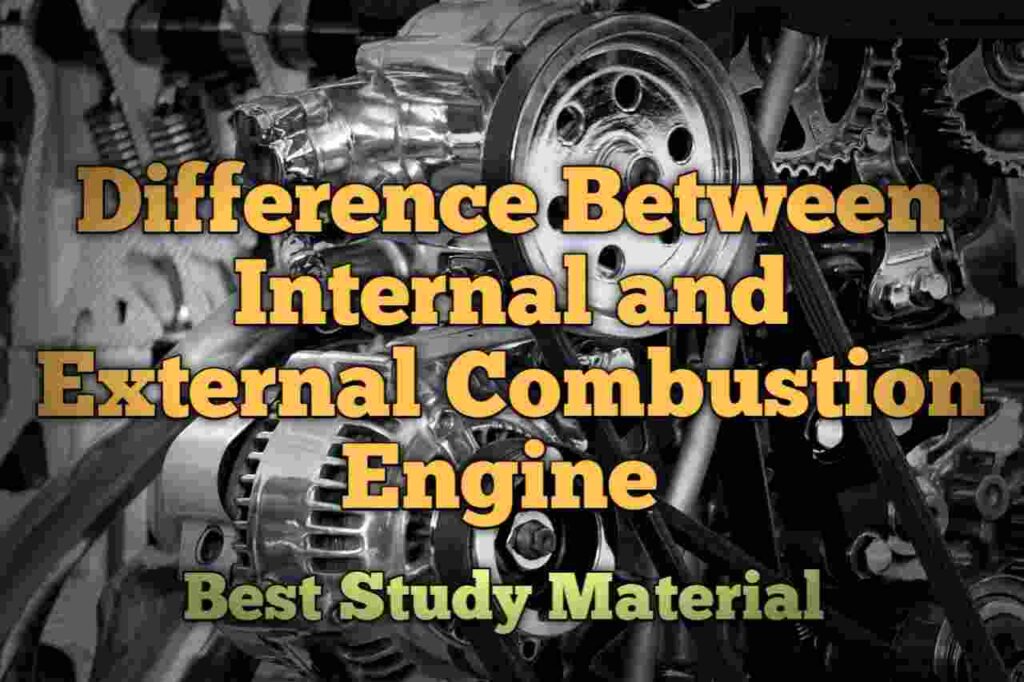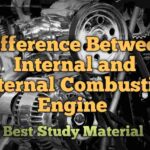Internal and External Combustion Engine: In a world full of Technology and Machinery engines play an important role in every field. So here we discuss two types of Engines that are IC Engine (Internal Combustion Engine) and EC Engine (External Combustion Engine).
What is Engine
It is a device that converts one form of energy to another form of useful energy. The energy conversion after the burning of fuels is Chemical Energy to Thermal Energy, Thermal Energy to Mechanical Energy. The involvement of Engines is between Thermal Energy to Mechanical Energy.
Combustion Engine Classification
On the basis of Combustion, Engine are classified into two types Internal Combustion Engine and External Combustion Engine.
Internal Combustion Engine
In Internal Combustion Engine (ICE) the burning or combustion of the fuel takes place inside the cylinder For Example Automobiles Engine, in Petrol Engine, and the Diesel Engine.
External Combustion Engine
In an External Combustion Engine (ECE), the combustion of the fuel takes place outside the engine, For Example, Steam Engine, Closed Gas Turbine, etc.
Difference between ICE and ECE
- In EC Engine the combustion of fuel is outside the engine while in IC Engine the combustion of fuel is inside the engine.
- As EC Engines are bulky due to the presence of auxiliary apparatus like boilers and condense while IC Engines are light and compact.
- EC Engines have a high ratio of weight to power output while IC Engines have a low ratio of weight to power output.
- In EC Engine we can use cheaper fuels including solid fuels while in IC Engine we have to use high-grade fuels with proper filtration.
- EC Engine should offer a low efficiency of up to 15.20% while IC Engine offers a High efficiency of about 35.40%.
Advantages of IC Engine
There are several advantages of an Internal Combustion Engine. Here we mentioned some of them.
- IC Engine have Simplicity in Mechanics.
- IC Engines have low initial costs because of the absence of boilers, turbines, condenses, etc.
- IC Engines have higher efficiency than External Combustion Engine.
- IC Engines have a high Powe to Weight Ratio.
- It is beneficial for small power requirement applications.
- The starting time of this engine is much less.
- Needs less maintenance in comparison to others.
Disadvantages of IC Engine
- The variety of fuels that can be used is limited to various fine-quality gaseous and liquid fuels.
- The cost of the Fuels is High.
- Engine emissions are generally high compared to EC Engine.
- Not suitable for large-scale power generation.
- In the case of Reciprocating, IC noise is generated due to detonations.
Classifications of IC Engine
The engines are classified on the basis of stokes, cycle, types of fuels, Ignition methods, etc.
- On the basis of Strokes used, engines are classified into Two Stroke Cycle Engine and Four Stroke Cycle Engine.
- On the basis of the Cycle used, engines are classified into Otto Cycle Engine, Diesel Cycle Engine, and Dual Cycle Engines.
- On the basis of the Types of Fuels used, engines are classified into Petrol Engines, Diesel Engines, and Gas Engine.
- On the basis of Types of Ignition Methods, engines are classified into Spark Ignitions (SI) and Compression Ignitions (CI).
- On the basis of Types of Cooling Systems, engines are classified as Air Cooled Engines and Water Cooled Engines.
- On the basis of Types of Different Positions of Cylinder, engines are classified as Horizontal Cylinder Engines, Vertical Cylinder Engines, and Incline Cylinder Engines.
TDC and BDC in on ICE
- Top Dead Center (TDC): It is the position of the piston when it is farthest from the crankshaft.
- Bottom Dead Center (BDC): It is the position of the piston when it is nearest to the crankshaft.
Stroke and Stroke Lenght
When a piston moves from TDC to BDC or BDC to TDC then it is known as a Stroke. The Lenght Between Top Dead Center and the Bottom Dead Center is known as Stroke Length.
Bore
The bore is the inner diameter of the cylinder or the diameter of the piston face. It is represented by Symbol D.
Swept Volume
The volume displaced by the piston as it travels through one stroke is known as Swept Volume. The formula of Swept Volume is Vs = Pi/4 x D^2 x L. If these are K number of cylinders then the total swept volume is Vs = K Pi/4 x D^2 x L.
Clearance Volume
It is the volume of the cylinder when the piston is at TDC or IDC, therefore it is the minimum volume. V min is equal to Vc. V max is equal to Vs + Vc.
Compression Ratio in an IC Engine (r)
It is the ratio of Volume before compression and after compression. Volume before Compression is Vc + Vs and Volume after Compression is Vc.
r = Vc + Vs/ Vc
For SI sparks go from 6 to 10 and for CI Sparks goes from 16 to 22.
Four Stroke Engine
Cycle operations (Intake, Compression, Expansion or Power and Exhaust) are complete in four-stroke of the pistons or two revolutions (720 Degrees) of the crank. The four-stroke engine may be SI or CI.
Suction Stroke
- The movement of the piston is down from TDC to BDC.
- The valve of the inlet is open and the exhaust is closed.
- Work on the principle of providing reduced pressure in the cylinder in comparison to atmospheric pressure.
- With the help of an inlet valve the Air Fuel Mixture are sucked into the cylinder.
Compression Stroke
- The movement of the piston is up from BDC to TDC.
- Both inlet and exhaust valves are closed.
- Temperature and pressure increased due to the compression of the air-fuel mixture in the cylinder.
Power or Expansion Stroke
- The burning gases expand rapidly.
- The Force is exerted by the gases on the piston.
- The piston is pushed from TDC to BDC.
- This Reciprocating motion of the piston is converted into rotatory motions of the crankshaft through the connecting rod.
- Both Inlet and Exhaust valves are closed.
Exhaust Stroke
- Piston Moves upward from BDC to TDC.
- The valves of the Exhaust are opened and the Inlet is closed.
- With the help of Exhaust Valve the burnt gas is forced out into the atmosphere.
- The slightly open inlet valve before TDC and the cylinder are getting ready for receiving freshly charged to start a new cycle.
Read More: Introduction to Mechatronics.






